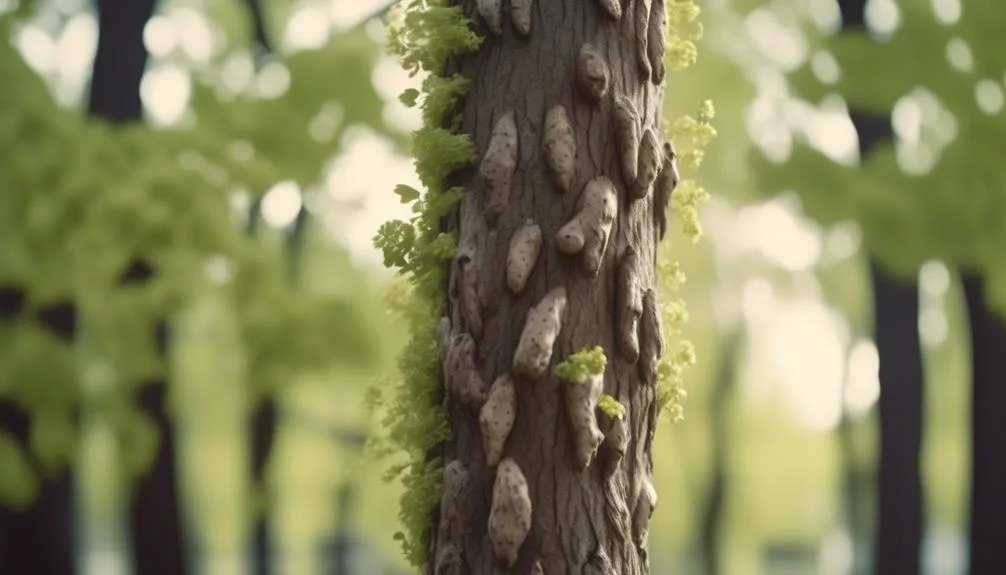Dealing with stubborn elm tree suckers in your yard can be a real challenge. But fear not, there are effective ways to control them.
From identifying and removing them to preventing their return, there are several methods to regain control over your yard.
Let's explore how you can take charge of those pesky suckers and reclaim your beautiful elm tree landscape.
Identifying Elm Tree Suckers
Identify elm tree suckers by looking for small shoots growing from the base of the tree or from the roots. These suckers often emerge near the trunk and can be easily mistaken for young saplings. They're characterized by their rapid growth and distinct green leaves.
To manage elm tree suckers, it's essential to promptly remove them by cutting them as close to the base as possible. Regularly inspect the base of the tree and the surrounding area to catch any new suckers early.
To prevent the regrowth of suckers, apply a herbicide to the freshly cut area. Additionally, maintaining the health of the elm tree through proper watering and fertilization can reduce the likelihood of sucker growth.
Removing Elm Tree Suckers
To effectively control the growth of elm tree suckers, promptly removing them by cutting as close to the base as possible is essential. When removing elm tree suckers, follow these steps:
- Carefully inspect the area around the base of the tree to identify all suckers.
- Use sharp pruning shears to cut the suckers as close to the base as possible, without causing damage to the parent tree.
- Dispose of the removed suckers properly to prevent re-rooting.
- Consider installing a root barrier to prevent the spread of suckers in the future.
If the suckers persist, chemical control methods can be considered, but it's important to carefully follow the product instructions and consider potential impacts on the surrounding environment. Always consult with a professional arborist for guidance on the most effective removal methods for your specific elm tree.
Preventing Elm Tree Suckers
Consider installing a root barrier to effectively prevent the spread of elm tree suckers in the future. Root barrier installation is an excellent method for containing the growth of elm tree roots and reducing the likelihood of suckers emerging in unwanted areas. These barriers are typically made of durable materials and can be placed underground to block the lateral spread of roots.
Additionally, chemical control can be used to prevent suckers from sprouting. Applying a suitable herbicide to the area around the elm tree can inhibit sucker growth by suppressing the development of new shoots.
When used in combination, root barriers and chemical control measures can significantly reduce the occurrence of elm tree suckers, helping to maintain the desired appearance and health of the tree.
Pruning Elm Tree Suckers
Prune elm tree suckers in the early spring to effectively manage the tree's growth and promote a healthier appearance. When pruning, use sharp, clean pruning shears to make precise cuts. Remove suckers as close to the base as possible without damaging the parent tree. Focus on removing the entire sucker, including its roots, to prevent regrowth.
Consider installing a root barrier to prevent the spread of suckers from the tree's roots. When using a root barrier, ensure it extends at least 2 feet deep into the soil to effectively contain the tree's roots.
Regularly inspect the area around the elm tree for any new suckers and promptly remove them to maintain the tree's appearance and health.
Treating Elm Tree Suckers
When dealing with elm tree suckers, carefully inspect the area around the tree for any signs of regrowth and promptly address them to maintain the tree's health and appearance.
To prevent suckers from reappearing, consider installing root barriers. These barriers are effective in containing the roots and reducing sucker growth.
When using chemical treatments, prioritize safety. Always follow the instructions on the product label and wear appropriate protective gear.
Before applying any chemical treatments, ensure that they're suitable for use around elm trees and won't harm the tree itself.
When used correctly, chemical treatments can be effective in controlling suckers. However, it's important to be cautious and consider alternative methods if there are concerns about the impact on the tree and surrounding environment.
Conclusion
Incorporating these tips into your regular tree care routine will ensure a healthy and tidy elm tree.
By identifying, removing, preventing, pruning, and treating suckers as needed, you can maintain the beauty of your tree without unnecessary hassle.
Stay vigilant in your inspections and proactive in your actions to keep unwanted growth in check.
Happy gardening, and may your elm tree flourish with vitality and grace.

My interest in trees started when I first saw the giant sequoias in Yosemite.
I was a teenager then, and I remember thinking, “I need to learn more about this.”
That moment stuck with me.
A few years later, I went on to study forestry at Michigan Tech.
Since graduating, I’ve worked in a mix of hands-on tree care and community education.
I’ve spent over ten years helping people understand how to plant, maintain, and protect the trees in their neighborhoods.
I don’t see trees as just part of the landscape.
They are living things that make a real difference in our daily lives.
